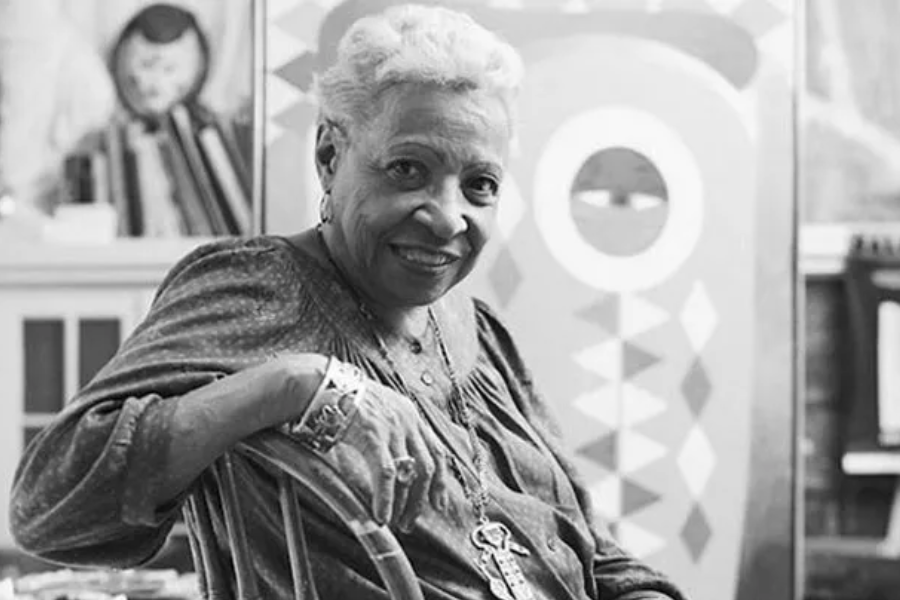The Harlem Renaissance, often referred to as the New Negro Movement was a period of extraordinary artistic growth in the 1920s, where African American culture flourished in various forms, including art, music, and literature. Harlem became the heart of this cultural resurgence, providing a space where Black artists expressed their experiences, identities, and aspirations. While renowned figures like Langston Hughes, Zora Neale Hurston, and Claude McKay are commonly celebrated as icons of the era, many lesser-known individuals made substantial contributions. One such influential figure was Gertrude Parthenia McBrown, an accomplished poet, musician, educator, and activist who helped define the ethos of the Harlem Renaissance.
Gertrude Parthenia McBrown was a multifaceted African American woman whose work spanned several artistic domains, including poetry, music, and education. She advocated for cultural pride, social justice, and racial awareness, channeling her creativity to address the complex issues of racial identity and inequality. Despite the barriers placed before her as a Black woman in a segregated society, McBrown left behind a rich legacy, impacting both the artistic community and the educational landscape.
Her work continues to resonate with audiences today, symbolizing the resilience and strength of Black women in the arts. Through her contributions, McBrown also highlighted the overlooked voices that played a critical role in shaping the Harlem Renaissance, ensuring that their place in history is firmly acknowledged.
Early Years and Educational Journey
Born in an era marked by systemic racism, Gertrude Parthenia McBrown was raised in a family that placed a high value on education and community engagement. These core values empowered her to face the challenges of the time with confidence and resolve. Her formative years were shaped by a passion for the arts and a steadfast commitment to societal progress.
Education played a central role in McBrown’s life. In a period when access to higher education was rare for African American women, she pursued learning relentlessly. This dedication to her studies provided her with the knowledge and skills that would later influence her work in literature, music, and teaching.
As a woman of color, McBrown encountered the intersecting challenges of both racism and sexism. Yet, she excelled in her chosen fields, embodying the very essence of resilience that characterized the Harlem Renaissance. Her success serves as a powerful reminder of the importance of perseverance and self-confidence in the face of societal obstacles.
Gertrude Parthenia McBrown and the Cultural Movement of Harlem
The Harlem Renaissance was far more than just a creative movement; it represented a profound statement of identity and empowerment for African Americans. In this vibrant cultural climate, McBrown flourished, adding her voice to the collective artistic expression that defined the period. The Renaissance offered a platform for artists like McBrown to proudly showcase their heritage, aspirations, and vision for the future.
McBrown’s poetry was an insightful exploration of Black identity and the struggles that came with it. Her writing was rooted in racial pride, and her work often reflected themes of resilience and hope, celebrating the strength of the African American community. These themes were in line with the broader literary currents of the Harlem Renaissance, where artists sought to both honor Black culture and challenge the pervasive injustices of the time.
Through her creative work, McBrown emphasized the critical importance of cultural pride and solidarity. She firmly believed in using her voice to elevate her community, making her a significant figure in the broader movement to redefine Black identity during the Harlem Renaissance.
Gertrude Parthenia McBrown’s Artistic Impact
McBrown’s poetry frequently centered on themes of resilience, pride, and the triumphs of the African American experience. Her words painted vivid pictures of both the joys and challenges that Black communities faced, reflecting the collective consciousness of the era. Her work inspired many of her contemporaries and future generations, much like Langston Hughes, whose own work shared similar themes of hope and perseverance.
In addition to her literary talents, McBrown was a gifted musician. She blended the emotional depth of African American spirituals with the structured formality of classical music, creating compositions that celebrated her heritage while innovating within established musical traditions. This fusion of styles was a testament to her commitment to preserving cultural traditions while exploring new creative possibilities.
For McBrown, art was not merely a form of expression; it was a call for social change. Her poetry and music were powerful tools for addressing racial inequality, positioning her as a strong advocate for social justice through the arts. Her work reflected the Renaissance’s ideals, where art was seen as a vehicle for societal transformation.
Gertrude Parthenia McBrown’s Legacy in Education
Beyond her work as an artist, McBrown was also an influential educator, extending her impact to the classroom. She taught in schools and colleges, where she encouraged students to take pride in their cultural heritage and to embrace education as a pathway to empowerment. Her approach to teaching often intertwined music and poetry, creating a dynamic and engaging educational experience for her pupils.
As an educator, McBrown played a pivotal role in shaping the intellectual and creative lives of young African Americans. She inspired countless students to pursue academic excellence and to express themselves freely through the arts. Her contributions to education are a testament to her belief in the transformative power of knowledge and self-expression.
For McBrown, education was not just about imparting knowledge—it was a tool for social and personal liberation. She believed that an educated and united community could overcome the systemic challenges that sought to hold it back, a vision that guided both her teaching and her artistic endeavors.
Overcoming Obstacles: The Struggles She Endured
Gertrude Parthenia McBrown’s path was not without its challenges, shaped by the racial and gender prejudices prevalent in the early 20th century. As a Black woman, she encountered discrimination that often limited her opportunities. However, her unwavering determination and resilience allowed her to rise above these barriers.
Despite her considerable talents and contributions, McBrown did not gain the widespread recognition enjoyed by some of her contemporaries. The historical disregard for women, particularly Black women, in the arts played a role in her relative obscurity within the broader cultural narrative.
Financial hardships were another obstacle McBrown had to contend with, a reality faced by many artists of the era. Still, her commitment to her craft remained steadfast, and she continued to use both her art and her role as an educator to support herself while uplifting her community.
The Enduring Influence of Gertrude Parthenia McBrown
McBrown’s creative fusion of poetry, music, and activism left a lasting legacy, influencing future generations of African American artists. She was a pioneer in using her art as a vehicle for social change, setting the stage for others to follow.
In recent years, scholars have begun to revisit McBrown’s work, bringing her contributions to the forefront of cultural conversations. This renewed interest ensures that her powerful voice continues to resonate with audiences, both old and new.
The themes McBrown explored—resilience, solidarity, and pride in one’s culture—remain as pertinent today as they were in her time. Her body of work serves as a lasting reminder of how art can be harnessed to address pressing social issues and create stronger, more cohesive communities.
Gertrude Parthenia McBrown’s Distinct Role Among Harlem Renaissance Luminaries
While McBrown’s work shared the Harlem Renaissance’s core values of cultural pride and social justice, her unique approach set her apart from other notable figures of the movement. Unlike Langston Hughes, who was deeply influenced by jazz rhythms, or Zora Neale Hurston, whose writing often drew from folk traditions, McBrown blended classical music with African American cultural forms, creating a distinctive artistic voice.
Her wide-ranging contributions as a poet, musician, and educator made McBrown a standout figure of the Harlem Renaissance. Her work not only reflected the era’s ideals but also offered a fresh perspective, shaped by her multifaceted identity as both an artist and an educator.
Key Facts About Gertrude Parthenia McBrown:
- Multifaceted Artist
Gertrude Parthenia McBrown was a poet, musician, educator, and activist who made significant contributions to African American culture during the Harlem Renaissance. - Harlem Renaissance Contributor
She played a pivotal role in the Harlem Renaissance, a cultural movement in the 1920s that emphasized African American identity, creativity, and empowerment through art, literature, and music. - Promoter of African American Identity
McBrown used her work to celebrate Black culture, promote racial pride, and advocate for social justice. Her artistic output often highlighted themes of resilience, identity, and community strength. - Artistic Fusion
Known for blending African American spirituals with classical music, McBrown’s musical compositions reflected her commitment to honoring her heritage while pushing the boundaries of artistic expression. - Poetry with Purpose
As a poet, McBrown’s verses conveyed the struggles and triumphs of African Americans. Her poetry often focused on hope, strength, and the social injustices that affected her community. - Educator and Advocate
McBrown was also a teacher who used education as a tool for empowerment. She encouraged African American students to value their cultural heritage and pursue academic and artistic excellence. - Cultural Pioneer
While many figures of the Harlem Renaissance, like Langston Hughes and Zora Neale Hurston, became well-known, McBrown remained an important but under-recognized figure who contributed significantly to shaping the era’s cultural landscape. - Struggled with Discrimination
As a Black woman in a racially segregated society, McBrown faced both racial and gender discrimination but overcame these barriers through resilience and determination, gaining respect for her intellectual and artistic contributions. - Legacy
Despite not achieving the same level of fame as some of her contemporaries, McBrown’s legacy continues to inspire future generations of African American artists and educators, and her work is gaining renewed attention through modern scholarly research. - Impact on Harlem’s Cultural Scene
McBrown was an integral part of the Harlem community, contributing not just through her art but also by supporting the cultural and educational movements of the time. She was involved in various community-building activities, often combining art and activism to address social issues. - Themes of Empowerment
The themes of unity, cultural pride, and social justice were central to McBrown’s work, and her creative output remains relevant in today’s conversations about race, art, and activism.
Conclusion: The Lasting Legacy of Gertrude Parthenia McBrown
The life and achievements of Gertrude Parthenia McBrown encapsulate the spirit of the Harlem Renaissance. Through her work as a poet, musician, and educator, McBrown contributed to shaping the cultural and social movements of her time.
Acknowledging McBrown’s accomplishments ensures that her contributions continue to inspire and educate future generations. Her story exemplifies the resilience and creativity of African American women who defied societal limitations to leave a profound impact on history.
McBrown’s enduring legacy serves as a testament to the transformative power of both art and education. Her work stands as a beacon of hope and a reminder of the indomitable spirit that characterized the Harlem Renaissance.
Frequently Asked Questions About Gertrude Parthenia
Who was Gertrude Parthenia McBrown?
Gertrude Parthenia McBrown was a multifaceted artist and educator whose contributions to the Harlem Renaissance were pivotal. As a poet, musician, and advocate, she played a crucial role in promoting African American culture and fighting for social justice.
What were the key artistic contributions of McBrown?
McBrown’s works spanned both poetry and music, through which she celebrated the richness and strength of Black identity. She skillfully combined African American spirituals with classical music elements, creating compositions that reflected both cultural pride and artistic innovation.
In what ways did McBrown impact African American culture?
Through her creative endeavors and educational work, McBrown fostered a deep sense of pride in African American culture. She emphasized the value of education, cultural awareness, and collective empowerment, encouraging her community to embrace their heritage and strive for social progress.
Stay in touch to get more updates & alerts on Live Hint! Thank you



